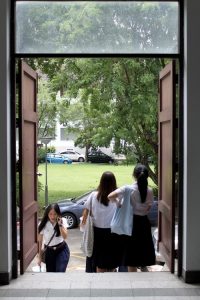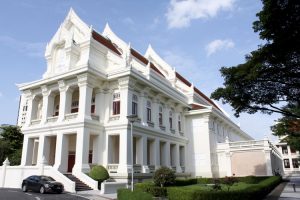Attending Chulalongkorn (Chula) University
By Jen Louie, Foster Undergraduate participating in an exchange with Chulalongkorn University in Bangkok, Thailand.
Campus: The campus itself is quite large, similar to UW, with a mix of old and new buildings and the occasional large grass areas. Chula is at the center of Bangkok; at one end is a popular luxury shopping center and at the other is another shopping center linked to the MRT station. There are canteens located throughout campus, open all day for students to eat at. Lunch costs 30 baht, $1 USD, for a plate of rice with meat or noodles and vegetables. There is a wide variety and it is extremely cheap. Additionally, there is a nice weekend market from Thursday to Sunday right near the BBA building. They sell different foods and snacks and drinks for a cheap price, as well as fresh fruits and vegetables. While my area of campus is a bit older and plain in appearance, the arts and social science buildings have beautiful architecture and design.
 Uniforms: Students attending Chulalongkorn University are required to wear a uniform, and exchange students are treated no differently. Men are required to wear black pants and a white button down with the Chula belt. Girls are required to wear either a long flowing dark navy skirt or a tighter black pencil skirt, along with a short-sleeves white collared button down with Chula pins and buttons, and the Chula belt. The Chula uniform carries meaning beyond the gates of the campus. Chula uniforms embody respect from Thai people because of the reputation of the school. One of my professors said that Chula students pay for pride. The student body is majority wealthy Thai students who are sent with great pride to be part of a community that is so favorably looked upon in Bangkok. I’ve never had a uniform, attending public school my entire life, and I definitely never wished I had one. But I am grateful that I am required to wear one here. Uniforms ease the decision of what to wear, put all students on equivalent playing fields in terms of appearance, and help close the gap between foreigner and local.
Uniforms: Students attending Chulalongkorn University are required to wear a uniform, and exchange students are treated no differently. Men are required to wear black pants and a white button down with the Chula belt. Girls are required to wear either a long flowing dark navy skirt or a tighter black pencil skirt, along with a short-sleeves white collared button down with Chula pins and buttons, and the Chula belt. The Chula uniform carries meaning beyond the gates of the campus. Chula uniforms embody respect from Thai people because of the reputation of the school. One of my professors said that Chula students pay for pride. The student body is majority wealthy Thai students who are sent with great pride to be part of a community that is so favorably looked upon in Bangkok. I’ve never had a uniform, attending public school my entire life, and I definitely never wished I had one. But I am grateful that I am required to wear one here. Uniforms ease the decision of what to wear, put all students on equivalent playing fields in terms of appearance, and help close the gap between foreigner and local.
Class: The schedule of class is vastly different from the University of Washington, and most universities in the US. I’m taking four classes, while local Chula students take an average of six to seven a semester. Each class is once a week for three hours, which is about twice as long as the average lecture I’m used to attending. However, my schedule worked out nicely so that I have a four-day weekend and only go to campus for class from Tuesday to Thursday (some students even have a five-day weekend). While the classes are long and sometimes difficult to get through, the four-day weekend is well worth it. I am enrolled in Business & Organization Management, Product and Operations Management, International Marketing, and Consumer Behavior.
 Student Behavior: Based on the first two classes I attended, I was quite surprised by the class environment. Many of the Thai students showed up late to class, some talked with their friends in small groups throughout the lecture, some were on their cellphones the whole time, and some slept right on the table. I was shocked by how little they seemed to care and respect the professor and other students. At one point during my afternoon Product and Op Management class this girl took out a comb and mirror to brush her friend’s hair. Many of them spent the class eating and socializing quietly, paying little to no attention to what the teacher was saying. Thankfully, the next two classes would sway my opinion about student behavior in the classroom. In the other two classes (International Marketing and Consumer Behavior), all students were more engaged and respectful towards the professor. I’m not sure if it had to do with these classes being for a higher grade level or the more authoritative nature of the professor. But luckily these students seemed to come prepared to learn, participate, and engage in meaningful discussion and lectures. As time goes on I’ll see how student behavior varies from that of a typical lecture style classroom in America. So far it appears to feel slightly more like high school than college.
Student Behavior: Based on the first two classes I attended, I was quite surprised by the class environment. Many of the Thai students showed up late to class, some talked with their friends in small groups throughout the lecture, some were on their cellphones the whole time, and some slept right on the table. I was shocked by how little they seemed to care and respect the professor and other students. At one point during my afternoon Product and Op Management class this girl took out a comb and mirror to brush her friend’s hair. Many of them spent the class eating and socializing quietly, paying little to no attention to what the teacher was saying. Thankfully, the next two classes would sway my opinion about student behavior in the classroom. In the other two classes (International Marketing and Consumer Behavior), all students were more engaged and respectful towards the professor. I’m not sure if it had to do with these classes being for a higher grade level or the more authoritative nature of the professor. But luckily these students seemed to come prepared to learn, participate, and engage in meaningful discussion and lectures. As time goes on I’ll see how student behavior varies from that of a typical lecture style classroom in America. So far it appears to feel slightly more like high school than college.
 Teaching differences: My professors have a nice range of personality. Two in particular have stood out to me. My consumer behavior professor, who is the current Dean of Marketing, has a very entertaining, silly, and perplexing personality. He cracks jokes constantly, poking fun at society, himself, and the habits of other cultures. His style of teaching and grading is more relaxed than most, valuing experience above all else. He repeatedly said, “Come to learn, not to study.” And elaborated on how specifically for exchange students (who made up the majority of this class), attending Chula on exchange goes beyond just experiencing the country; it extends to understanding the culture, behavior, and lifestyle of Thai people. So as a result of his values, the time spent in that class will likely revolve more around gaining an experience and having fun than reading and studying material.
Teaching differences: My professors have a nice range of personality. Two in particular have stood out to me. My consumer behavior professor, who is the current Dean of Marketing, has a very entertaining, silly, and perplexing personality. He cracks jokes constantly, poking fun at society, himself, and the habits of other cultures. His style of teaching and grading is more relaxed than most, valuing experience above all else. He repeatedly said, “Come to learn, not to study.” And elaborated on how specifically for exchange students (who made up the majority of this class), attending Chula on exchange goes beyond just experiencing the country; it extends to understanding the culture, behavior, and lifestyle of Thai people. So as a result of his values, the time spent in that class will likely revolve more around gaining an experience and having fun than reading and studying material.
The professor for my International Marketing class captivated my attention for nearly all 3 hours of the lecture. She explained her background and reasoning for teaching the course, while touching upon subjects I found extremely insightful. Her introduction touched upon meta skill development, the importance of analyzing experiences to distill lessons, and the power of empathy. While that seems like a random list of philosophical topics, she never failed to bring back her point to how it relates directly to the class and subject of international marketing.
I’m actually incredibly excited to continue learning from all my professors. I look forward to gaining multiple different experiences in each classroom and hope to maintain the mindset of approaching academics ready to learn, not study.
1 Response
Leave a Reply
You must be logged in to post a comment.

Were you a scholar at the Chulalongkorn University?